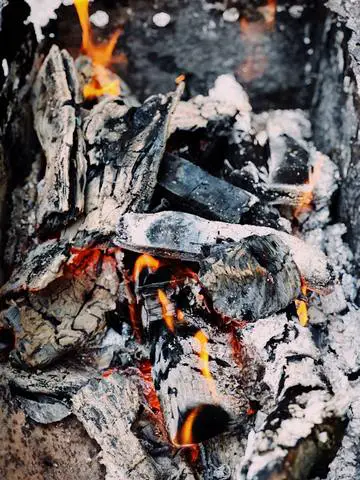We’ve all been there. We think we have just brewed a superb cup of delectable coffee, and… that taste, that smell. The two in tandem culminating in the flavor of a wet ashtray or the soot from the fireplace, or something else entirely! While this may be a fanciful set of descriptions, I’m sure many of us have experienced a “burnt” or “ashy” flavor in our coffee. These flavors can arise from a variety of causes, ranging from the condition of the coffee beans, to the heat of the brewing water, to the length of brewing time.
The SCAA flavor Wheel
To aid us in identifying the specific flavor we are noticing, the Specialty Coffee Association of America has a handy and colorful flavor wheel. This wheel was first printed in 1995, and it catalogues the many different tastes, hints, aromas and notes that can be found in a cup of coffee. In the roasted category, there is a subcategory called “burnt” alongside two others: “tobacco” and “pipe tobacco,” If we follow the burnt subcategory further, there are several notes within the burnt family. They include “brown roast,” “smoky,” “ashy,” and “acrid.”
Some of these flavors are intentionally cultivated in coffee to suit certain tastes, while others result from accidents that occur in the brewing process. Smoky and ashy flavors most often occur in dark roasts; this makes sense because dark roasts are roasted longer. For dark roasts, the flame-charred method of darkening the beans is intended to produce smoky and ashy flavors that are to be savored and enjoyed.

However, if a burnt flavor makes an appearance with a light roast bean? Double-check your beans’ freshness, your brewing methods and/or your methods of keeping your coffee hot. One or more of these may be the culprit of your coffee having undesirable smoky or ashy notes.
Avoiding Coffee Beans Burnt like a Well-Done Steak!
A dark roast yielding too much of a smoky or ashy flavor can also be a negative. There are cases where the beans are over-roasted or, to put it bluntly, burnt. In this case, yes- you are essentially drinking burnt and ashy beans. A well-roasted dark bean can have some pleasant smoky and slightly ashy hints, flavors, aromas and notes, but if they are overpoweringly strong or eclipse some of the other flavor profiles, you may be experiencing overdone beans!
This problem is hard to avoid- the roasting of the beans is done outside of our control before they even made available for retail. However, while this may sound like a mere case of “buyers beware,” there are methods to reduce the likelihood of getting stuck with a bag of burnt beans. Try looking for smaller batch roasts. Larger batches of beans are more likely mass roasted for larger production, often resulting in burnt beans. If small batch roasts are hard to find, perhaps opt for lighter roasts.
Stale Coffee: Ashy Flavor?
The next possible reason for coffee to take on a burnt, smoky or ashy taste is one that normally is under our control: whether our beans are fresh. Stale coffee, in the case of particular dark roasts, may yield a burnt or bitter tasting brew. This can be easily remedied, though.
First, make sure to store your beans properly. Beans exposed to the air can lose a lot of their flavor and freshness, and will go stale if exposed to too much oxygen, leading to a burnt tasting brew. Luckily, there are various bags, tins and bins available on the market for storing beans in a way that keeps them fresh and keeps out as much oxygen as possible.
This next tip is for the whole-beans crowd. When grinding beans, only grind an amount that you will use in a single brewing. The reason ground beans go stale faster than whole beans is because they have less surface area.

This is not to say that it’s impossible to pre-grind your beans and then store them. It just means that your grounds will not have as long of a shelf life as your whole beans will. If you brew coffee often and must keep a supply of ground to keep up with your coffee demand, make sure to store them in a cool, dry place in as airtight a case as possible. Some coffee lovers prefer to store their beans in the refrigerator or freezer. While this is a perfectly valid method of coffee storage, ensuring the storage container your beans is airtight is of utmost importance when freezing or chilling your beans, as oxygen can cause freezer burn.
Can a Hot Plate Burn your Coffee?
Another reason your coffee may be exhibiting a burnt or ashy flavor may be due to the way you are keeping it warm! Similar to soup left on a warmer too long, coffee will burn if left on the hot plate for too long. The ideal solution is to drink your coffee as soon as it is brewed. The fresher your coffee is, the better. The sooner your coffee is in your cup and out of the pot, the less likely it is to burn and create smoky or ashy notes.
Another option is to pour your coffee into a thermos or other receptacle where it can stay warm but won’t be exposed to heat. Coffee brewed in the morning can be enjoyed later in the afternoon, while not getting over roasted in the process! Vacuum-sealed mugs are a great solution for keeping your morning brew hot throughout the day.
Another option would be to cold brew it. Cold brewing eliminates the risk of the hot plate burning your coffee and, assuming your beans are fresh and were roasted properly, ashy notes should not be present. The cold brew alternative is also a good option for those who want to store coffee for later. Cold and Dutch-brewed coffee can be made in bulk and then stored for up to a week. While Dutch and cold brews are less than ideal for those preferring for hot coffee, the other drawback to opting for cold and Dutch brews would be the fact that brewing times can last from 12 to 24 hours. Ensuring that you have prepared cold or a Dutch brew well in advance, having strained it, stored it, and chilled it in a receptacle can be less than convenient.
The four main reasons for smoky, burnt or ashy tasting coffee

Lets review the four main factors that can impact your coffee and give it a smoky, ashy or burnt taste, aroma or flavor.
The first is that the beans are exhibiting desirable “burnt” notes resulting from the normal roasting process. In this case, dark roasted beans will imbue cups with subtle “burnt” notes- but you should try to develop a palette for and enjoy these flavors.
The second is that the “burnt” notes are resulting from over-roasting of beans. In these cases, usually the burnt or ashy flavors are much stronger.
The third potential culprit is stale coffee beans. Stale coffee beans often produce bitter notes that can be perceived as ashy.
The fourth possible culprit for a smoky, ashy or burnt coffee taste is your hotplate. Try to get your coffee off the hot plate as soon as possible- use a vacuum thermos or opt for cold brew.
When it comes to ashy and burnt tasting coffee, this list hopefully will save you angst during brewing in the future! Remember some of our handy tips and tricks and alternative options mentioned above to ensure an excellent coffee experience.
